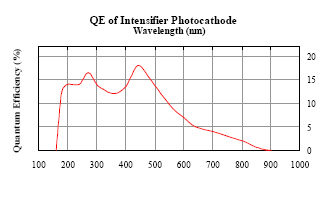Difference between revisions of "Hybrid Photodiode"
Senderovich (talk | contribs) m |
Senderovich (talk | contribs) m |
||
| Line 12: | Line 12: | ||
<math>\tilde{V}_{out}(\omega)=\frac{\alpha}{a\omega^2+ib\omega+c}\tilde{I}_{in}(\omega)</math> | <math>\tilde{V}_{out}(\omega)=\frac{\alpha}{a\omega^2+ib\omega+c}\tilde{I}_{in}(\omega)</math> | ||
| − | where the parameters in the gain pre-factor are: | + | where the parameters in the gain pre-factor (g(ω)) are: |
* <math>\alpha = -G/C_F</math> | * <math>\alpha = -G/C_F</math> | ||
* <math>a = -(1+C_{HPD}/C_F)</math> | * <math>a = -(1+C_{HPD}/C_F)</math> | ||
| Line 20: | Line 20: | ||
The subscript 'F' in the above expressions stands for op-amp feedback components. G is the gain-bandwidth product - nominally 1.6 GHz but was adjusted to 21 GHz to produce physical results. (Applying this response to the measured responses of LED pulses with the narrow nominal bandwidth produced negative LED intensities!) | The subscript 'F' in the above expressions stands for op-amp feedback components. G is the gain-bandwidth product - nominally 1.6 GHz but was adjusted to 21 GHz to produce physical results. (Applying this response to the measured responses of LED pulses with the narrow nominal bandwidth produced negative LED intensities!) | ||
| − | The time domain | + | The HPD response in the time domain is a straightforward inverse Fourier Transform: |
| + | <math>g(t)=\int\limits_{-\infty}^{\infty}\frac{\alpha}{a\omega^2+ib\omega+c}\, e^{i\omega t}\, d\omega = | ||
| + | \int\limits_{-\infty}^{\infty}\frac{\alpha}{(\omega-\omega_+)(\omega-\omega_-)}\, e^{i\omega t}\, d\omega</math> | ||
| − | Depending on the constants provided, | + | where <math>\omega_\pm = \frac{-ib}{2a} \pm \frac{ \sqrt{-b^2-4ac} }{2a} = \omega_1 \pm i\omega_2</math> |
| + | |||
| + | |||
| + | Thus, in the complex space, this integral is equivalent to the residues of two poles. Depending on the constants provided, the poles are situated either on the positive imaginary axis or along the -ib/2a line. For the physical constant of our circuit, the former set of poles is relevant. The resulting response function is: | ||
| + | |||
| + | <math>g(t) = \frac{2\pi\alpha}{\omega_2} e^{i\omega_1 t} \sinh \omega_2 t </math> | ||
| + | |||
| + | Since the response seen on the HPD circuit output is the convolution of the light pulse shape (f<sub>L</sub>) with the response function of the HPD, the pulse shape can be recovered by deconvolving the measured signal (f<sub>M</sub>) with the g(ω). By the convolution theorem: | ||
| + | |||
| + | <math>f_L(t) = \mathcal{F}^{-1} \left\{ \frac{f_M(\omega)}{g(\omega)} \right\} </math> | ||
| + | |||
| + | This is a delicate procedure, in practice, as the division is sensitive to the small high-frequency errors. Direct application of this results in very noisy results. A good remedy is a low-pass filter on the spectrum of the measured signal (taking care to preserve the shape of the signal by keeping the cutoff well above the highest relevant frequencies). | ||
Revision as of 21:47, 13 July 2008
A Hybrid Photodiode from DEP was used as a photo-intensity reference for most light tests in the lab. It particular it served to calibrate the detection efficiencies of the candidate Silicon Photomultipliers (SiPMs) for the Tagger Microscope.
The quantum efficiency of this device is shown in the adjacent figure. The DEP-supplied device provides a gain factor of 2700 at the HV of 12 kV and additionally requires 40 - 80 V bias to collect the electrons across the diode junction. Built into the package is a transimpedance amplifier with 50 kΩ || 1.5 pF feedback, requiring ±5 V supplies. The amplifier circuit also contains a 51.1 Ω resistor in series with the output. Reading out the HPD signal from the amplifier with 50 Ω termination creates a about a factor of two (50 Ω/(50 Ω + 51.1 Ω)) on top of the 50 kΩ current to voltage conversion.
Frequency Response
Based on the circuit described above, a two-pole response model was developed of the form:
where the parameters in the gain pre-factor (g(ω)) are:
The subscript 'F' in the above expressions stands for op-amp feedback components. G is the gain-bandwidth product - nominally 1.6 GHz but was adjusted to 21 GHz to produce physical results. (Applying this response to the measured responses of LED pulses with the narrow nominal bandwidth produced negative LED intensities!)
The HPD response in the time domain is a straightforward inverse Fourier Transform:
where
Thus, in the complex space, this integral is equivalent to the residues of two poles. Depending on the constants provided, the poles are situated either on the positive imaginary axis or along the -ib/2a line. For the physical constant of our circuit, the former set of poles is relevant. The resulting response function is:
Since the response seen on the HPD circuit output is the convolution of the light pulse shape (fL) with the response function of the HPD, the pulse shape can be recovered by deconvolving the measured signal (fM) with the g(ω). By the convolution theorem:
This is a delicate procedure, in practice, as the division is sensitive to the small high-frequency errors. Direct application of this results in very noisy results. A good remedy is a low-pass filter on the spectrum of the measured signal (taking care to preserve the shape of the signal by keeping the cutoff well above the highest relevant frequencies).









